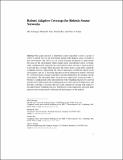Robust Adaptive Coverage for Robotic Sensor Networks
Author(s)
Schwager, Mac; Vitus, Michael P.; Rus, Daniela; Tomlin, Claire J.
DownloadAccepted version (449.6Kb)
Open Access Policy
Open Access Policy
Creative Commons Attribution-Noncommercial-Share Alike
Terms of use
Metadata
Show full item recordAbstract
© Springer International Publishing Switzerland 2017. This paper presents a distributed control algorithm to drive a group of robots to spread out over an environment and provide adaptive sensor coverage of that environment. The robots use an on-line learning mechanism to approximate the areas in the environment which require more concentrated sensor coverage, while simultaneously exploring the environment before moving to final positions to provide this coverage. More precisely, the robots learn a scalar field, called the weighting function, representing the relative importance of different regions in the environment, and use a Traveling Salesperson based exploration method, followed by a Voronoi-based coverage controller to position themselves for sensing over the environment. The algorithm differs from previous approaches in that provable robustness is emphasized in the representation of the weighting function. It is proved that the robots approximate the weighting function with a known bounded error, and that they converge to locations that are locally optimal for sensing with respect to the approximate weighting function. Simulations using empirically measured light intensity data are presented to illustrate the performance of the method.
Date issued
2016-08-26Department
Massachusetts Institute of Technology. Computer Science and Artificial Intelligence LaboratoryPublisher
Springer International Publishing
Citation
Schwager, Mac, Vitus, Michael P., Rus, Daniela and Tomlin, Claire J. 2016. "Robust Adaptive Coverage for Robotic Sensor Networks."
Version: Author's final manuscript
ISSN
1610-7438
1610-742X